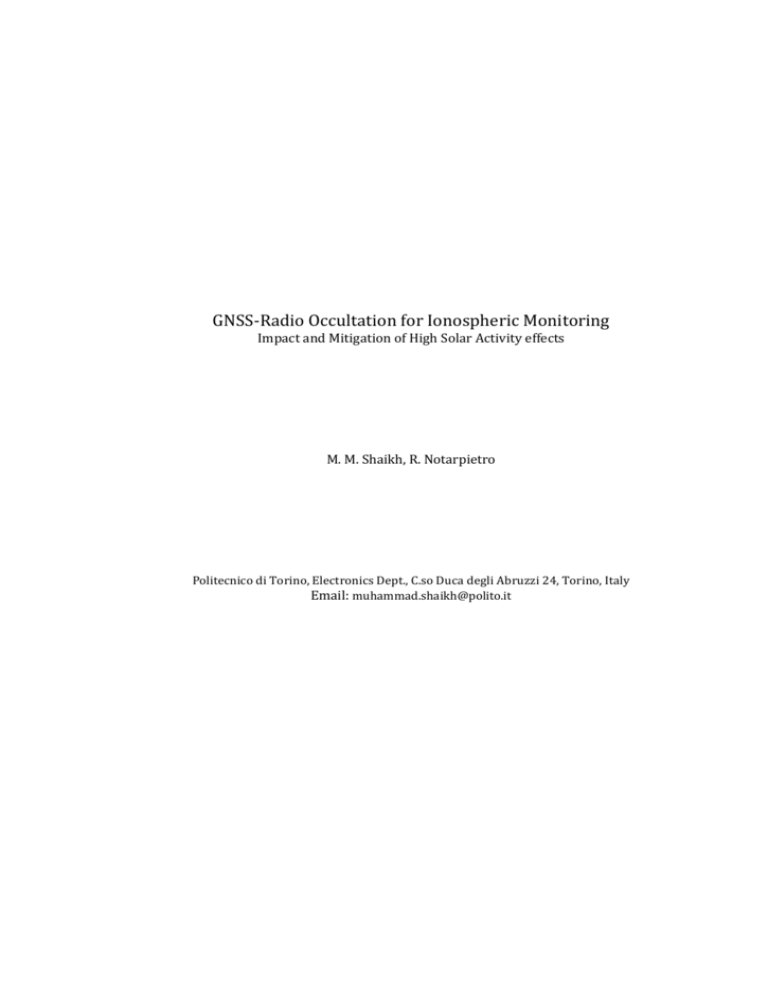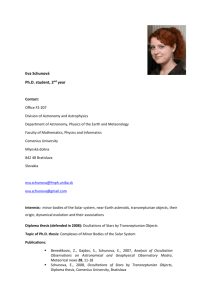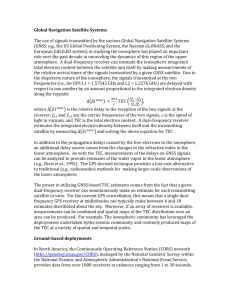GNSS-Radio Occultation for Ionospheric Monitoring Impact and
advertisement

GNSS-Radio Occultation for Ionospheric Monitoring Impact and Mitigation of High Solar Activity effects M. M. Shaikh, R. Notarpietro Politecnico di Torino, Electronics Dept., C.so Duca degli Abruzzi 24, Torino, Italy Email: muhammad.shaikh@polito.it TRANSMIT is an initiative funded by the European Commission through a Marie Curie Initial Training Network (ITN). The main aim of such networks is to improve the career perspectives of young researchers. TRANSMIT provides a coordinated program of academic and industrial training, focused on atmospheric phenomena that can significantly impair a wide range of systems and applications that are at the core of several activities embedded in our daily life. TRANSMIT deals with the harmful effects of the ionosphere on these systems, which will become increasingly significant as we approach the next solar maximum, predicted for 2013. The main aim of the project is to develop a set of integrated real-time state-of-the-art tools capable to mitigate ionospheric threats to Global Navigation Satellite Systems (GNSS) and related applications, in areas such as civil aviation, marine navigation and land transportation. The project will provide Europe with the next generation of researchers in this field, equipping them with skills developed through a comprehensive and coordinated training program. TRANSMIT counts on an exceptional set of partners, encompassing both academia and end users, including the aerospace and satellite communications sectors, as well as GNSS system designers and service providers, major user operators and receiver manufacturers. At the core of TRANSMIT is a group of young scientists, the TRANSMIT fellows, who will be trained in the scope of the project and ultimately carry out the project’s research work, which will culminate with a prototype of the Ionospheric Perturbation Detection and Monitoring (IPDM) network. It is a network which was proposed by European experts and supported by the European Space Agency (ESA) as the way forward to deliver the state-of-the-art to protect the range of essential systems vulnerable to these ionospheric threats. An industry led project, TRANSMIT will address and find solutions, through coordinated secondments of its fellows at industrial partners, to real life problems related to ionospheric threats. TRANSMIT is divided in 13 PhD projects (ESR1 to ESR13) going on in seven institutes of six countries. The project I’m involved in will focus on the development of improved algorithms for better ionospheric compensation and for better characterization of electron density profiles. Their assimilation into imaging and forecasting algorithms will be investigated exploiting strong collaborations with ICTP (International Center for Theoritical Physics), ISC (Institute for Complex Systems), UoB (University of Bath), Thales Alenia Space and other partners of the network. We may divide the overall work in two sub-projects as follows: Electron Density Profile Retrieval Radio Occultation is extremely attractive, but the inversion techniques usually applied should be checked and maybe improved, in particular in case of high solar activity conditions 1. TEC derived measurements are necessary between LEO and GPS satellites for consequent electron density profile retrieval. This has to be done by occulted LEO at both ends of the orbit (A1 and A2 points in Figure 1) with the same GPS satellite during an occultation event. With current radio occultation missions, it is only possible to perform TEC measurements at the highest point of LEO orbit (point B in Figure 1 below). If none of the previous measurements are available, it is necessary to model in some way the “external” TEC (from GPS to B or GPS to A2), in particular during high solar activity. Techniques/algorithms will be implemented and tested. As far as the electron density profile retrieval technique is concerned, during normal solar activity, Onion Peeling algorithm (Figure 2) works quite well, since deviations from electron density spherical symmetry distribution are often “acceptable” (depending also on the observing geometry and on the ray perigee (Local Time). This is not the case shown in Figure 3 (electron density profiles derived using two different Onion Peeling implementations, given the same input data, observed in the framework of the COSMIC mission). Unfortunately, during high solar activity, this is not valid and Onion Peeling is not so effective. In this project, an improved technique/algorithm aided by a model (Nequick, Forecast, Tomography) or external information will be developed and its effectiveness will be investigated. 2. Tracking techniques of current radio occultation missions are not so efficient and need improvements. Onboard receivers track L2 latter than L1 in the rising event and loose lock of L2 early in the setting event. This limits the amount of data available for the ionospheric compensation (more about it in the next section). Efforts will be done to improve the tracking behavior of onboard receivers. A simple tabular approach to this problem may be defined as follows: Solar Activity Low L2 Tracking Improvement for Radio Occultation Receiver Adoption of new tracking techniques and use of different thresholds inside the receiver may be developed and tested with the help of: i. Climatological models, NeQuick High 3. Adoption of new tracking techniques and use of different thresholds inside the receiver may be developed and tested with the help of: i. Numerical Iono modelling and uploading updates to receiver ii. NeQuick Moreover, in this project, improved requirements will be suggested to GNSS Radio Occultation receiver manufacturers (ThalesAlenia Space), in order to define the optimal ionospheric observing strategy. In the framework of this sub-Project, Radio Occultation experimental data from available missions will be used in order to carry out both the analysis (points 1 and 2 above). Already available inversion procedures able to extract electron density profiles from Radio Occultation measurements will be applied and, if possible, improved, considering the impact of models (model aided inversion). Moreover, assimilation of Radio Occultation products into imaging and forecasting algorithms will also be investigated together with other Partners (ICTP, ISC, UoB). Figure 1: Radio Occultation using GPS satellites Figure 2: Onion peeling algorithm for electron density profile retrieval Figure 3: Electron density profiles derived using two different Onion Peeling implementations Ionospheric Compensation Ionospheric compensation procedures must be necessarily applied to Radio Occultation observations before extracting neutral atmospheric / tropospheric profiles. Problems arise in particular when L2 data are not available or in case of high solar activity, when the standard first order compensation procedures are not appropriate. Considering GPS standard Radio Occultation observations, L2 is normally tracked after L1 in a rising event, and L2 is lost before L1 in a setting one. For ionospheric compensation, L1 and L2 must be contemporaneously available. Work will be done to make L2 data available in these situations by applying extrapolation techniques on L2 data. It is also possible to lose L2 tracking for a while: in this case interpolation techniques should be adopted. A simple, tabular approach can be defined as follows: Solar Activity L1 & L2 Available Contemporaneously Ionospheric compensation can be done with already existing algorithms. Low High No linear combination could be applied in this condition. Different algorithms could be developed depending on solar activity L1 & L2 Not Available Contemporaneously i. We need to extrapolate L2 for the compensation of missing data (using data or models based on linear combination of L1 and L2). ii. Then, ionospheric compensation can be done with already existing algorithms. i. Extrapolation of missing L2 data ii. Ionospheric Compensation (No linear combination. We need forecasting models for ionospheric compensation using extrapolated L2 data ) During normal solar conditions, we are able to compensate for ionosphere quite well using existing algorithms like linear combination with exception to the time when L2 is not available, during an occultation event. In this case, we need to extrapolate for L2 first and then use the ionospheric compensation algorithms on the available data. During high solar activity some analysis should also be carried out in order to verify if external data (ionospheric models, Nequick, Tomography, Forecast) are suitable.



